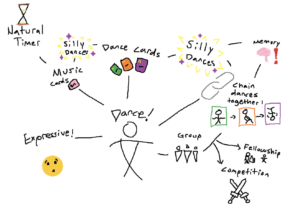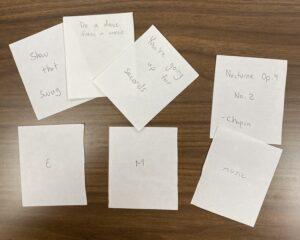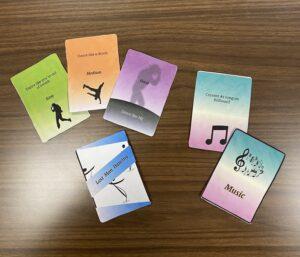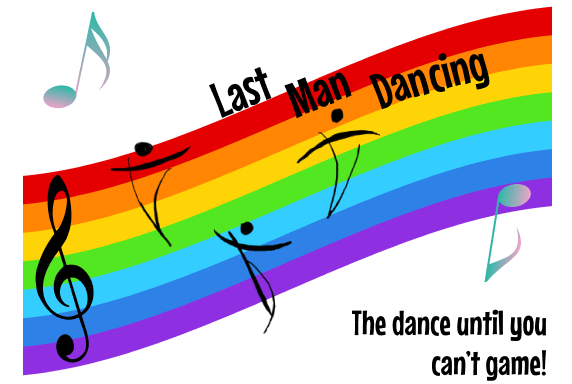1. Artist’s Statement
“Last Man Dancing” is a social fellowship game with the purpose of bringing together players of varying levels of dancing ability in a fresh and fun format. This game intends to bring people slowly out of their shells and to be comfortable as each player is instructed to not only remember, but create dance moves to a random song. Since much of the game is open to interpretation, we hope to respark the creativity, movement, and fun within friends or people who have yet to become friends. Very few people are willing to simply bust a move out in front of people they don’t know—which is why we added cards to ease the curve. This way, everyone (even skilled dancers,) has to make a funny or iconic move in which they will see each other player reenact lest they risk losing. As more and more dances are added, camaraderie as well as competition rise as people try to be the last person dancing. Overall, “Last Man Dancing” serves to test players’ creativity and memory above all else as a means to build social connection in a way where everyone is seen as equal.
2. Concept Map

3. Initial decisions about formal elements and values of the game
In our initial design of “Last Man Dancing”, we have the players take turns to create dance moves. Each player must first do the chain of moves done by previous players and add a new move on top of that. There are music cards and prompt cards: The group draws a music card at the beginning of each round to decide the music played during that round. Each player draws a prompt card whenever it is their turn, and the move they create must fulfill the prompt on the card. The game ends when a player messes up the dance chain and they will receive a penalty from the group.
With this initial design, we intended to build Fellowship through the Challenge of passing on dance moves among players, encourage Expression of individuality by taking advantage of dance as a paragon of creative activity, bring about pleasures of Sensation through dancing to the music, scale the Challenge by having players memorize cumulative dance moves and improvise new moves based on prompts, and consolidate Fellowship through creating an environment where everyone can be comfortable showing either their talent or goofiness/awkwardness to the group.
In “Last Man Dancing”, the basic objective for the players is to replicate the previous dance moves and pass them on to the next player. When different people are doing the same dance moves, they tend to add their own flavor to them, which would give rise to (mostly positive) reactions from the group. When playtesting the initial version of the game, we noticed that when a player did another player’s move in their own way, people either got impressed (“That was so well done!”) or laughed in a friendly way. So “Last Man Dancing” creates wonderful group dynamics through passing something on while adding something new.
On top of the basic mechanism, “Last Man Dancing” scales the challenge for the players by having them memorize a series of dance moves in a rather short amount of time and dance them out. As the game goes on, the challenge automatically increases, with more moves being added to the chain and people starting to blank on earlier moves. Additionally, we add variety to the challenge by having the players draw from our well-designed prompt cards and dance based on the prompts, which can include “Dance with your left leg still” “Dance like MJ” “Dance like you just failed an exam”. These constraints on the specificity, the style, and the emotions expressed through the dance move are not just meant to be challenging, but also to make the dance entertaining. The variety of prompt cards also make each round of the game a unique experience and thus make the game more replayable.
In designing “Last Man Dancing”, we ground the fun of the game in making room for the players’ self-expression. Not only can players add their own flavor to the previous dance moves, they also need to append a new dance move to the dance chain. Each player can decide what dance move they improvise and however easy or challenging it is. It is really their time to come up with the moves that could most represent them and win the cheers from the group. Moreover, in “Last Man Dancing”, we create enjoyable experiences for players from multiple dimensions: Not only is it gratifying to create self-expressive dance moves, it is also a great enjoyment dancing to a wide variety of music handpicked by us and will come up in random order depending on which music card players draw.
By encouraging the players to express their individuality and adding in goofy and funny elements through the use of prompt cards, “Last Man Dancing” ultimately aims at enabling a rich experience of fellowship where users can celebrate one another’s uniqueness and build emotional connections and unforgettable memories.
4. Testing and Iteration History
Our initial playtest was done between us as a group. Our initial question for this playtest was “Is the game fun in any way?” Prior to playtesting, we hypothesized that the game would work best amongst a group of close friends. This line of reasoning came from a predisposed belief that most people are afraid to dance in front of strangers/acquaintances due to embarrassment. As such, we worried early on about getting players invested enough to dance and have fun. Our first playtest as a group was a mini experiment on this. We were mainly only acquainted through the class, and thus considered ourselves a meaningful test for this worry. The results turned out to be a pleasant surprise as the lack of dancing skills added a silly/goofy atmosphere that helped in making connection fun. During this same playtest, we decided to try and find strangers to play with us to test the experience with someone completely new. While the reactions were a little less favorable, they weren’t entirely negative. We found ourselves connecting with strangers over dance moves!
[Cards for playtest 1]

Our next playtest would be in class where this time we intended to test the core mechanics of the game. During our ideation phase we came up with two ways of playing the game: the current individual-dance-chain-to-victory game, and a team versus playstyle. Due to time constraints we were only able to test our first idea. However, we reached great success with this initial runthrough that we decided to stick with this version. Players enjoyed the chaining aspect of the game as it allowed the difficulty to scale with size and scale quickly. We noticed that players were often surprised by each other’s interpretations of the dance prompts. This led to great self-expression and creativity being applauded and highlighted by other players. The entire group was also very supportive of one another. While one of the core rules is “You are allowed to be as strict as you’d like with the moves you created.” many of the players were more invested in seeing everyone succeed. This did mean the game dragged a little and wasn’t as fast-paced as we had envisioned. Some points of confusion did come up with how long each player had to recall the chain and execute, as many were slowly talking through the prompts to try and remember. In this initial version, ousted players could not rejoin. In reaction to this many players indicated that ousted players were permanently left out of the magic circle and therefore no longer had fun. We added the rejoin mechanic in response to this feedback. Other players also indicated that penalties instead of being out would be fun. Some ideas included 18+ penalties such as alcoholic drinks or stripping. While there’s an audience for it, it wasn’t the audience we were aiming for.
Our second playtest was also conducted in class. For this one, we wanted to bring in the music aspect and test how well it worked as a backdrop as structure for the game. Music cards were drawn at the start of each round, and dictated the length of each round. While we noticed that the music was a nice backdrop for players to dance to, many of them questioned the place of the music in the game. We received feedback wishing for more integration of the music into the game’s mechanics.
With this, we went back to the drawing board and gathered together the pieces for our final prototype. This time, we added ideas from feedback that we hoped would add more structure and dynamics to the game. Whenever a round ended (signaled by the ending of a song), the current dancing player would be ousted. We believed this added an extra dynamic to the game where players weren’t just competing against each other, but also against the game itself. To lessen the severity of this punishment, we wanted to choose songs that were culturally relevant. This meant players were familiar with the songs and could strategize accordingly. We also included “Pick your own song” cards that allowed players control over the game. Additionally, we formally added in the “rejoin” mechanic that allowed ousted players another chance at joining the game. This final playtest was to gauge the player’s reactions to these new mechanics. During this playtest we also asked questions of “Did you feel like you had had enough interactions with other players?” as well as “What strategies did you use when playing?” In reaction to the added mechanics, we received positive feedback regarding the music mechanic. Players said “Yes, time adds a competitive aspect to it” and “Songs are kinda like a treat” when asked about the impact of the music on the game. Players also expressed that they liked the game more than expected despite never having danced before, and that the game was a great group bonding activity. Common strategies that were used included watching other players and reading prompts to themselves. This inherently fostered interaction between playtesters as well.
[Cards for final play test]

Overall, we found great fun within our play tests. It was amazing taking a simple premise such as dancing one after another to a more formalized game that built atop itself and added interesting mechanics. In the end, I believe we were able to achieve our goal of the fun of Fellowship through Challenge, as well as creating avenues for Expression of our players. In the future, we hope to incorporate a lot more ideas that we brainstormed and also received in feedback. For example, we wanted to add in penalty cards that players drew at the start of the game which could be used on any player throughout the duration of the game. We believe this would encourage more player interactions and interesting dynamics, however we were unable to fully realize it given the time frame and constraints for this project.
5. Link to Final Prototype
https://docs.google.com/presentation/d/15RbSNVOoKOY3viZfLjQ89HHVv5bV4CYK_FhpuRiyX5w/edit#slide=id.p
6. Video of the Final Play-test
https://drive.google.com/file/d/1vQe_F5QKo0OP8CSG7loHoeijtZrtuZM6/view?usp=sharing


